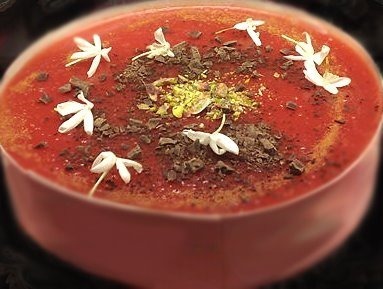U' Gelu Ri Muluni: Palermo's Watermelon Pudding
When my great-grandfather Niccolò Cipollina departed Palermo in 1905 at the age of six, he left a world of traditional foods behind. As he grew up in lower Manhattan and later the Bronx, his diet conformed to a new environment, and gradually the few family recipes preserved from his native Sicily were tweaked beyond recognition. By the time he died in South Jersey, most memories of his youth in La Cala, Palermo's horseshoe-shaped natural harbor, had vanished — including recollections of the city's food and rituals. But when I return to Bisnonno Niccolò's hometown, where the waterfront still shows scars from WWII bombardments, I find the same centuries-old ingredients and flavors that he must have known as a child.
Today, as in centuries past, stalls peddle seasonal foods, like watermelons, which have a long history on the island. Although local lore attributes their arrival to Arab or Spanish conquerors (1,000 and 500 years ago, respectively), there's strong linguistic evidence — in the form of Classical and early medieval texts — that sweet watermelons have been in Southern Italy since at least the beginning of the Middle Ages, if not earlier. The Byzantine physician Anthimus refers to the presence of sweet watermelons in Italy in a 6th-century manual and suggests pairing them with vinegar and pennyroyal, meaning they arrived centuries before Arab fleets reached Sicilian shores. Regardless of their precise arrival date in Sicily, it is safe to say that the island's residents have long sought refreshment in this seasonal summer fruit of African origin.
From July through September, ripe watermelons are sold from market stalls, kiosks, and off the backs of mobile carts all over Palermo. Often, the melon is served simply, sliced into large wedges or roughly chopped into cubes. Watermelons are also transformed into granita, a refreshing icy slush often paired with brioche. The most elaborate preparation of this seasonal fruit is the festive u' gelu ri muluni — watermelon pudding.
To make u' gelu ri muluni, watermelon is roughly chopped, the rind is discarded, and the flesh is passed through a food mill to separate the juice from the fibers. The juice can be strained again, if desired, before being combined with starch and sugar over low heat. A minute or two after the mixture comes to a simmer, it can be poured into the desired form. The starch content binds it together, producing a slightly wobbly, pink-hued pudding that holds its shape. Some also add jasmine essence, cinnamon, vanilla, or even chocolate chips (after cooling, to mimic watermelon seeds). Common garnishes include jasmine flowers, ground pistachios, and grated bittersweet chocolate.

The pudding's ingredients and garnishes speak to the historic richness of Palermo's food culture; the sweetness of this and other local desserts is indebted to the 9th-century Arab conquerors who introduced cane sugar. Starch-thickened dishes, on the other hand, have ancient roots in the Mediterranean and beyond, with precedence in ancient Egypt, Rome, India, and Persia. Pistachios migrated to Italy from the East in antiquity, while bitter chocolate was introduced during the period of Spanish dominion.
U' gelu ri muluni's elements may be imports, but the preparation is deeply rooted in Palermo's local customs, and its production coincides with religious festivities such as the mid-July Feast of Santa Rosalia, patron saint of the city, and the August 15 Ferragosto holiday celebrating the Assumption of the Virgin Mary. Like many foods linked to religious rituals, u' gelu ri muluni is also prepared in homes and pastry shops for secular consumption, a fact that strengthens its cultural significance, securing a place for u' gelu ri muluni on Palermo's tables for generations to come.

